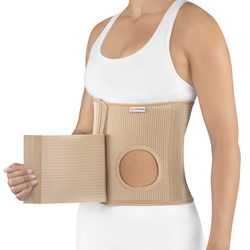Osteomy support belts
( number of products: 2 )Living with a stoma - how an ostomy belt can improve your quality of life
Most people who have stomas agree - their condition impedes their everyday lives. From changing ostomy bags and maintaining good hygiene around the affected area - these seemingly simple tasks take their toll on patients. However, a well-chosen ostomy belt can significantly improve the wearer’s quality of life - continue reading to find out how.
You may be asking yourself, “how do I find the right ostomy belt for myself?” Look for one that helps to stabilize the torso and does not irritate the skin around the stoma, make sure that it’s the right model, and above all, find one that fits your budget. You can find more expert tips on ostomy belts below, which will help you to choose the best belt that will improve your comfort of life!
Getting a stoma doesn’t mean it’s the end of the world!
A stoma can serve as either an artificial rectum, esophagus, stomach, duodenum, colon, ureters, urinary bladder, ileum and renal pelvis. The stoma is most often located on the front of the abdomen, which can create disbalance and cause a strain on the abdominal muscles, as well as those of the torso, thus reducing stability and self-esteem.
Stomas help to facilitate the process of excreting metabolic waste, such as feces or urine, which cannot occur physiologically if one has intestinal cancer, bladder cancer, or abdominal damage. Bear in mind however, that having a stoma isn’t the end of the world, and that you have to give up your quality of life. With the help of a professional ostomy belt, you can keep doing what you love and stay socially active. However, it’s important that you focus on protecting and maintaining good hygiene of the stoma - and a well-chosen ostomy suport will help with this.
Stomas and their variants
A stoma is generally a pink, oval opening that protrudes slightly out of the skin’s abdominal tissues. The stoma does not cause pain, as it is not innervated. What kind of stoma you have depends on its location on the body. These are the following types of stoma:
A colostomy is a surgical procedure in which a fragment of the colon is cut and attached to the anterior abdominal wall. The large intestine stoma is raised after rectal resection, which is usually done at the left lower abdomen, below the navel.
An Ileostomy is a surgical opening of the small intestine to be brought outside of the abdomen. This stoma is usually located on the right lower abdomen, below the navel.
A urostomy is the surgically-made opening between the skin's tissues and the ureter, kidneys or bladder. This stoma is very often located on the right side of the abdomen.
Stomas and ostomy support belts
There is a growing number of cases worldwide of people who are required to get stomas due to health reasons. However, simply getting the operation isn’t the only thing patients have to worry about. It takes a lot of effort in maintaining proper hygiene when using and replacing an ostomy bag, as well as in protecting the abdomen. Frequently replacing ostomy bags can wear you out throughout the day, but with an ostomy belt, your torso will remain stabilized, while keeping the stoma in the anatomically correct position.
An ostomy support belt is a recommended medical device for patients who have an external stoma, as well as those who have other conditions that affect the abdominal wall, such as abdominal hernias. In this case, it is worth considering looking into potential support belts for protecting your stoma, while reducing abdominal hernias.Its important to note that a common side-effect many people with stomas experience is an increase in back aches, especially in the lumbar region of the spine - which often requires an orthopedic belt for treatment. Familiarize yourself with our entire range of orthopedic belts in our store at e-MedicalBroker.com and find an ostomy belt just for you!
Which ostomy belt should I choose?
The size of the belt and location of the stoma are usually the deciding factors for which ostomy belt to choose - fortunately, our store offers a variety of models in a number of sizes. If required, we can cut a hole in the ostomy belt, in order to properly fit the diameter of the stoma. Not only is the location and size of the stoma important, but also choosing a belt that works well in keeping the ostomy bag in place, stabilizing the spine and adding support to the abdominal wall. It is also essential in preventing abdominal hernias from occurring, especially right after surgery.
Which ostomy belt is best for me?
Unfortunately, there is no one-size-fits-all answer - each case must be treated individually. An ostomy support is chosen based on the patient's current condition and their type of stoma. One of our more popular models we recommend is the Bort abdominal ostomy belt, which is light and provides good air flow, and is practically unnoticeable under clothing, while firmly stabilizing the torso around the stoma and most importantly, keeping the stoma bag in place. The second, highly recommended orthopedic belt is a classic hernia belt with an Orliman stoma hole, which provides support to the abdomen and spine and prevents hernias and pain. The third ostomy belt is the aforementioned model that can have a hole cut through it, making it easy to connect the ostomy bag without causing any problems.
How much does an ostomy belt cost?
The price of an ostomy belt depends on the materials it's made of, as well as the brand - prices generally range from 50 to around 100 dollars. Most patients tend to pay attention to the quality of the materials an ostomy belt is made of, as they have a significant importance in maintaining daily stoma hygiene, keeping the ostomy bag in place and reducing back pain. It is worth adding that the ostomy belts in our online medical store are not refundable, and quick payment methods are available as well. Additionally, our belts are carefully packed and shipped via courier delivery to the specified address.


